REOVIRIDAE
Naked, segmented, (-), dsRNA Group III
General Characteristics
- Reo is an acronym for respiratory enteric orphan.
- Reoviruses are ubiquitous agents.
- Human rotaviruses are rather fastidious agents, and for many years they could not be efficiently cultivated from clinical specimens.
- Strains identical serologically to the human reovirus serotypes have been recovered from a wide variety of animals, including mice, cattle, chimpanzees, dogs, cats, sheep, swine, horses, and monkeys.
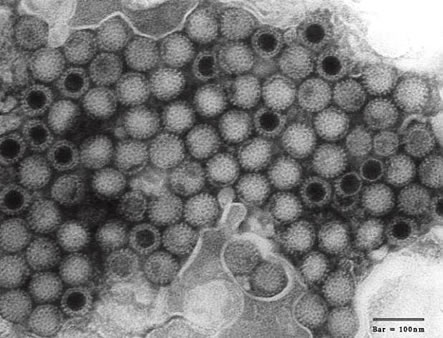
Electron micrograph from Stewart McNulty, Queens University, Belfast, via ICTV.
The term rotavirus is derived from the Latin word "rota," meaning wheel, and was suggested because the sharply defined circular outline of the outer capsid resembles the rim of a wheel placed on short spokes radiating from a wide hub.
Taxonomy
Family: Reoviridae
Genera
Orthoreovirus
Some infect humans
Orbivirus
Some infect humans
Coltivirus
Some infect humans
Rotavirus
Some infect humans
Aquareovirus
Infect fish
Cypovirus
The cytoplasmic polyhidrosis viruses
Phytoreovirus
Plants and insects
Fijivirus
Plants and insects
Groups differ in their antigens, epidemiology, association with disease, and ability to be cultured.
Structure
- Virions consist of an icosahedral capsid, a core, and a nucleoprotein complex.
- Complete particles have a double-layered capsid.
- The capsid is round and isometric and has a diameter of 60-80 nm.
- The capsid shells of virions are composed of two layers, or three layers.
- All shells are usually present, or the outer shell is often lost during preparation.
- When the outer layer is absent, they measure about 55 nm.
- Within the inner capsid is the 37-nm core, which contains the RNA genome.
- Surface projections are often lost during preparation, or not present, or distinct spikes protruding from the 12 vertices.
- Incomplete virus particles often present; they are empty capsids, or incompletely assembled capsids.
- Virus capsid is usually not enveloped, or enveloped when immature particles are budding into the endoplasmatic reticulum acquiring a transient lipid envelope before leaving the infected cell.
- Rotavirus particles have a distinctive wheel-like shape (except orbiviruses and coltiviruses that have amorphous outer capsids).
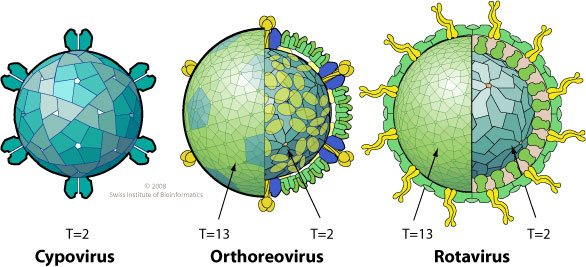
Source: Viral Zone
Genome
- Genome is monomeric and segmented.
- Contains 11 segments of dsRNA, in contrast to the reoviruses and orbiviruses, both of which contain 10 segments and the coltiviruses which contain 12 segments of dsRNA.
- The multipartite genome is found in one type of particle only.
- Each virion contains a single copy of the genome; a full length copy.
- The length of the complete genome is 18.2 to 30.5 kb.
- The 5' end of the genome has a cap.
- Cap sequence m7G5ppp5'GmpNp.
- 3' end has no poly (A) tract.
- Each virion contains a single copy of genome.
- Rotavirus RNA segments 1, 2, 3, and 6 encode inner capsid polypeptides VP1, VP2, VP3, and VP6, respectively, whereas RNA segments 4 and 7, 8, or 9 encode the major outer capsid polypeptides VP4 and VP7, respectively.
- The segmented genome of Rotavirus undergoes genetic reassortment during coinfection.
- The biochemical properties of human rotaviruses have not been studied extensively because these viruses are difficult to propagate in cell culture.
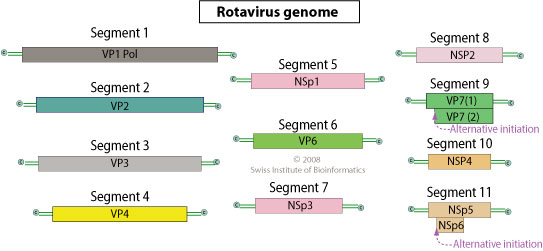
Source: Viral Zone
Replication
- Virus attaches to host receptors and is endocytosed into vesicles in the host cell.
- Particles are partially uncoated in lysosomes, but not entirely, and penetrates in the cytoplasm.
- Early transcription of the dsRNA genome by viral polymerase occurs inside this sub-viral particle (naked core), so that dsRNA is never exposed to the cytoplasm.
- Full-length plus-strand transcripts from each of the dsRNA segments are synthesized.
- These plus-strand transcripts are used as templates for translation and for the production of antisense strands, which remain associated with the (+) strand.
- (+)RNAs are encapsidated in a sub-viral particle, inside which they are transcribed to give RNA (-) molecules with which they become base-paired to produce dsRNA genomes.
- About 8 hours after infection, newly synthesized proteins and RNA, accumulate in the cytoplasm.
- Viral RNA is packaged into core particles, and viral capsid proteins assemble around the cores.
- These particles accumulate in vesicles of the endoplasmic reticulum and leave the viroplasm by budding through the membrane of the endoplasmic reticulum, where they acquire the outer capsid protein.
- The capsid is assembled on the sub-viral particle.
- The budding process (plus transient acquisition of an envelope) is unique to rotaviruses among members of the family Reoviridae.
- Mature virions are released from the cell by lysis.
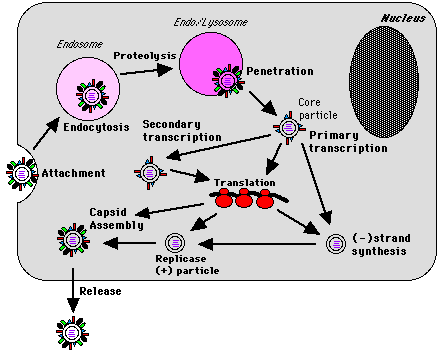
Source: Alan Cann, Virology
Diseases
Rotaviruses are major agents of severe diarrhea in infants and young children in developed and developing countries.
The most serious disease is Colorado tick fever, characterized by diphasic fever, headache, muscle pain, anorexia, leukopenia, and weakness; death is rare.
The group A rotaviruses are the most important agents of severe diarrhea in infants and young children and are prevalent worldwide.
The group B and C rotaviruses have a more limited distribution and are not considered to be an important cause of infantile diarrhea.
Groups D, E, F, and G have not been detected in humans.
Transmission
Rotavirus is easily spread through contaminated hands or objects and can survive for long periods of time on ordinary home surfaces.
The efficient transmission of rotavirus is evident by the presence of rotavirus antibody in most children by the age of 3 years.
This high prevalence of antibody is maintained into adulthood, probably a result of frequent reinfection.
Important sources of rotavirus infection for infants are individuals of any age who shed this virus.
Community outbreaks of rotavirus infection occur infrequently, probably because previous rotavirus exposure leads to protective immunity.
Rotaviruses also cause diarrhea in many newborn animals, such as calves, mice, piglets, foals, lambs, rabbits, deer, antelopes, apes, turkeys, chickens, goats, kittens, and puppy dogs.
.
Epidemiology
Despite the frequency of rotavirus diarrhea in developed countries, mortality is low.
Rotaviruses are recognized as the major agents of severe gastroenteritis of infants and young children in most areas of the world.
Rotavirus usually occurs between late fall and early spring in the United States.
Almost all children in the U.S. are likely to be infected with rotavirus before their 5th birthday.
Rotavirus moves across the country in a wave, beginning in the southwest in October and ending in the northeast in April or May.
Although rotavirus infection happens most often during these months,
infection may occur during other
Prevention
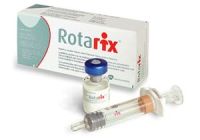
To help control the spread of Rotavirus, cleanliness and good hygiene should be maintained particularly in day cares and preschools which are high-risk areas for rotaviruses.
A vaccine such as Rotarix (Glaxo) may prevent this viral disease.